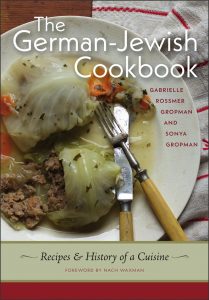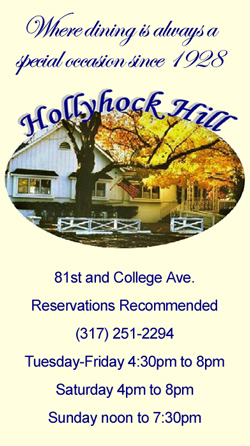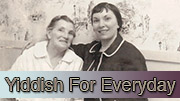
By Gabrielle (Gaby) Rossmer Gropman and her daughter, Sonya Gropman
By Tracie Mrakich
My late father, Kurt Freudenthal, immigrated with his family to the United States from Mannheim, Germany in 1939. Arriving in New York City on the SS Noordam, they continued their journey to Richmond, Ind., where their sponsor, an aunt, lived. Eventually, my grandparents moved to the Washington Heights neighborhood of NYC (upper Manhattan).
When I discovered through Facebook that a cookbook about German-Jewish cuisine was being published, I could not wait to get a copy of it. The author team of Gabrielle (Gaby) Rossmer Gropman and her daughter, Sonya Gropman, wanted to “preserve and document the cuisine of a nearly vanished culture.”
What makes this cookbook special is that the authors chronicled Jewish life in pre-war Germany and how German-Jewish immigrant families re-established their lives and culture in Washington Heights (chapter one).
The book is organized into sections – the introduction is about why Gaby and Sonya embarked on this project, their collaboration process, and how they defined German-Jewish cuisine. It also touches on Gaby’s family history. Gaby was just a one-year-old when her family immigrated to the United States from Bamberg, Germany in 1939, settling in Washington Heights. With a population of over 20,000, it was the largest surviving community of German Jews in the world. No wonder my grandparents left Richmond, Ind., for Washington Heights!
It is also in chapter one that we learn that Gaby grew up in a multi-generational household. Her maternal grandparents were able to leave Germany in 1940, joining the family in Washington Heights. They lived with her parents for the rest of their lives. Gaby spoke German at home and ate traditional German-Jewish meals prepared by her Oma (grandmother). She did not learn English until she entered kindergarten.
This chapter resonated with me, even though my father rarely talked about his life in Germany. What connects me to my German heritage is a figurine collection that my grandfather gave me during my last visit at his Washington Heights apartment. They were treasured items from their home in Germany. As a six-year-old, I did not know the circumstances of why they left Germany. It never occurred to me to ask how they chose what to bring with them to America, let alone the logistics in getting their belongings here.
Through reading The German-Jewish Cookbook, I learned about lift vans, which were wooden cargo containers. Before leaving for America, a Nazi inspector would document, approve (or disallow) and tax the items that families were allowed to ship to America in a lift van. The book includes a photograph of page one of an itemized list (and value) of the contents of Gaby’s grandparent’s lift van. Were my beloved figurines packed, inspected, taxed and shipped in a lift van?
The rest of the chapters are dedicated to the recipes and stories from Gaby’s family and also those recipes and stories collected through the interviews that took place in both the NYC area and Germany as part of the research for the book.
I chose to share a couple recipes from the book that were unfamiliar to me. One recipe is for Berches, the braided ceremonial bread of German Jews. Berches differs from challah in that it contains a boiled mashed potato instead of egg. The second recipe is Stuffed Cabbage Rolls with White Wine Sauce (featured on the book cover).
Berches is adapted from a recipe by Herta Bloch, an owner of a German-Jewish specialty meat shop, Bloch & Falk. From the 1930s through the 1990s, several Bloch & Falk locations existed in NYC.
Berches
7 cups (about 2 pounds) all-purpose flour, plus more as needed
2-1/4 cups warm water (more as needed, divided)
1 envelope (2-1/4 teaspoons) active dry yeast
1/2 teaspoon sugar
1/4 cup neutral flavored oil
1 white potato, boiled, peeled, mashed and cooled
1-1/2 tablespoons salt
1 egg white, lightly beaten
1 to 2 tablespoons poppy seeds
1. Place the flour in a large mixing bowl and make a well in the center.
2. Pour 1/4 cup of the warm water in the well. Add the yeast and sugar, stirring gently to dissolve. Let sit for 5 to 10 minutes until it is bubbling.
3. Add the oil, mashed potato and salt. With a wooden spoon (or your hands), start to mix the flour into the yeast mixture in the well. Gradually add more of the remaining 2 cups warm water as needed to moisten the flour (being careful not to add too much – the dough should remain firm and you probably will not use all 2 cups!), while continuing to mix.
4. Remove the dough from the bowl and put on a floured breadboard (or clean countertop). Knead by hand (press the dough hard with the palm of your hand, fold dough over and repeat) until all the flour is incorporated and the dough is well blended and smooth.
5. Wash and dry the mixing bowl and grease lightly with oil. Return the dough to the bowl, cover with a slightly damp kitchen towel, and place in a warm spot (such as an oven that has been warmed on low, then turned off). Let it rise until doubled in size, 1 to 2 hours.
6. Punch down the dough in the bowl. Return to the floured breadboard (or countertop) and knead until smooth.
7. Lightly oil a baking sheet. To make 1 extra large loaf, cut the dough into 3 equal parts and roll each part into a rope of equal length. Line up the 3 ropes in a parallel row Pinch the ends together at one end. Cross the left-hand rope over the middle rope (the left-hand rope now moves to the middle position) Cross the right hand rope over the middle rope. Continue crossing left- and right-hand ropes until you reach the end of the ropes. Pinch the ends together and tuck under. Place on a baking sheet. To make 2 medium loaves cut the dough in half and follow instructions for 1 extra large loaf.
8. Cover the loaves with the damp kitchen towel. Return the baking sheet to the warm spot and let the dough rise again until doubled in size, 1 to 1-1/2 hours.
9. Preheat the oven to 350 degrees F. Brush top of the bread with beaten egg white and sprinkle generously with poppy seeds. Bake for 30 to 40 minutes, or until the top is golden brown and when you tap the bottom it makes a hollow sound. Place on a wire rack to cool.
Stuffed Cabbage Rolls with White Wine Sauce
1 medium-large head green cabbage
Broth
1 tablespoon neutral flavored oil
1 medium size onion, thinly sliced
2 cups broth (beef, chicken, or vegetable), or a combination of broth and water
1/2 cup white wine
1 large carrot, peeled and cut into thin rounds (about ⅛ inch)
1 bay leaf
Large handful of fresh parsley, flat or curly
1 teaspoon kosher salt
1/4 teaspoon ground white or black pepper
1/2 teaspoon ground nutmeg
Stuffing
6 ounces stale bread rolls (bulkie?, Kaiser or Vienna)
1 pound of ground beef, veal or turkey (or a combination)
1 medium size onion, finely chopped
2 tablespoons finely chopped parsley
1 teaspoon of kosher salt
1/4 teaspoon ground white pepper
1/2 teaspoon ground nutmeg
1 large egg, beaten
Sauce
Up to 1 cup of additional broth as needed
Juice of 1 lemon
2 tablespoons of cornstarch
Additional seasonings as needed
Blanching the cabbage leaves:
Bring 2 to 3 quarts of water to a boil in a large pot over high heat. Trim the bottom core off the cabbage. Carefully remove the leaves from the cabbage, being sure to keep each leaf whole. If you have difficulty pulling the leaves off, make a cut around the bottom of the core with a sharp paring knife, releasing a layer of leaves. Continue making cuts as needed on each layer. Remove at least 12, and up to 18 leaves. Put 4 cabbage leaves at a time in the boiling water for 1 to 2 minutes until softened. Gently remove from the water with tongs, and place in a colander to drain. Continue until all the leaves have been blanched. Lay out the leaves on a clean kitchen towel to drain completely.
Making the broth:
Heat the oil in a large, oven safe, heavy-bottomed pot or Dutch oven. Add the sliced onion and cook over medium-low heat until transparent (do not let onion brown), stirring often, about 10 minutes. Add the broth, wine, carrot, bay leaf, parsley, kosher salt, pepper and nutmeg, stirring to combine. Bring to a boil over high heat, decrease the heat to medium high and cook for 2 minutes. Remove from heat and set aside.
Making the stuffing:
Put the bread rolls in a colander set in the sink. Moisten them with lukewarm water until they are soggy then squeeze them to remove as much excess water as you can. Tear them into 1-inch pieces.
Put the meat in a large mixing bowl. Add the chopped onion, torn bread, parley, salt, pepper, nutmeg and beaten egg. Mix thoroughly until all ingredients are incorporated.
Baking the stuff cabbage:
Preheat oven to 325 degree F. Put a drained cabbage leaf on a work surface. Place a heaping tablespoon of meat mixture in the hollow of the leaf at the stem end, about 1 inch from the bottom, then fold the left and right sides of the leaf over the filling. Fold the top of the leaf over the filling and tuck it under the stem end to make a snug, oval-shaped package. Put the finished roll, stem side down, in the pot with the broth. Continue filling and wrapping, adding each roll to the pot, until you have used all the cabbage leaves, or used up all the meat mixture. They should all fit in the pot in one layer (if you have one or two that don’t fit, it is okay to set them on top of the first layer). Cover the pot and bake for 1 hour.
Making the sauce:
Remove the cabbage rolls from the pot and put them in a serving dish. Measure the liquid remaining in the pot. If it has reduced to less than 1-1/2 cups, add more broth to equal that amount. Pour the broth back into the pot and add the lemon juice. Put a ladleful of the broth into a small bowl, add the cornstarch and stir to dissolve. Place the pot over medium heat. Pour the cornstarch mixture back into the large pot, stirring constantly. Simmer until the cornstarch turns clear and the sauce has thickened. Taste for seasoning, adding more salt, pepper or nutmeg if needed. Pour the sauce into a gravy boat or bowl. Serve the cabbage rolls warm, with the sauce on the side.
Gaby and Sonya are currently doing book tours and cooking demonstrations in both the United States and Germany. If you are interested in learning more about the authors and/or purchasing the book, you can follow them on Facebook @German-JewishCuisine or visit their website – https://germanjewishcuisine.com.
Tracie Mrakich grew up in Indianapolis and spent 18 years in the Los Angeles area (Pasadena) working in sales and marketing before moving back home to Indianapolis in 1999.






